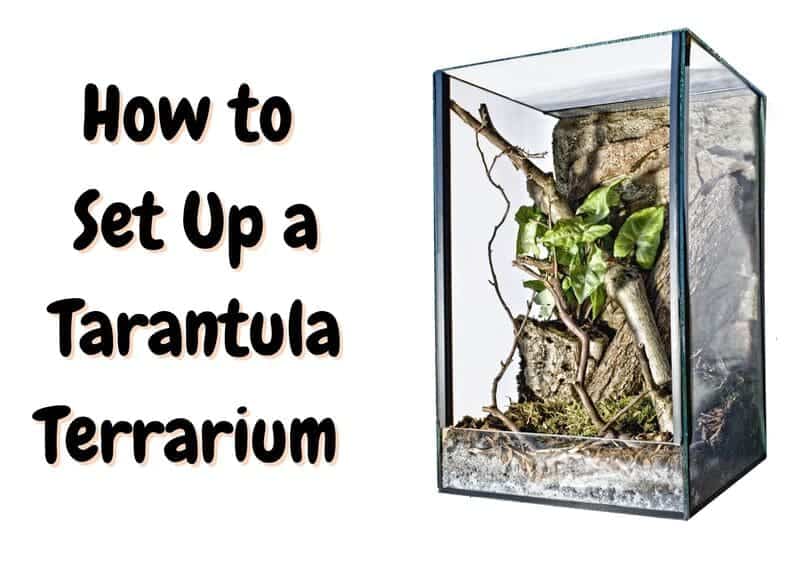Tarantula cage setup is important to the well-being of your spider. These arachnids have a territorial instinct that requires that they adapt to their new environment when they move from the pet store enclosure to their new home.
There are seven steps that will help you to set up your tarantula enclosure properly:
- Choose the right terrarium
- Place items inside the terrarium
- Get appropriate lighting
- Maintain adequate moisture
- Keep the temperature constant
- Select appropriate food and water
- Release your tarantula to its new environment.
1. Choosing the right terrarium
The first step for a good tarantula cage setup is selecting the right enclosure. While there are over 800 species of tarantulas, you can divide them into two primary groups – terrestrial and arboreal.
Terrestrial tarantulas live on the ground and may burrow in the ground, in which case they are called fossorial. These species should have enclosures that are wider than they are tall. They are clumsy climbers and if they fall from too high inside the tank, they may hurt their abdomen.
For terrestrial tarantulas, the container should be at least four times the size of the full-grown tarantula. So for a tarantula that has a 6″ leg span, your terrarium should be at least 24 inches wide.
Plastic containers are safe to use, although not the most aesthetic option. They are useful as you can stack them. You may purchase a clear plastic container with lids and drill small ventilation holes around the upper sides. Make sure the holes are not so big that your spider’s legs could get stuck in them.
Arboreal tarantulas spend more time climbing and need tall enclosures. It should be taller than it is wide as shown in the intro picture above.
Keep in mind that you do not want the enclosure to be too big, as it makes it harder for the tarantula to find and catch its food. With mature arboreal tarantulas, use a five-gallon enclosure.
2. Place items inside the terrarium
Your tarantula cage setup should include places for your pet to hide, along with a suitable substrate, such as coconut fiber. The main items that you need to place inside the terrarium include:
Most enclosures should include at least one to three inches of substrate and more if it is a fossorial tarantula. Other than the substrate, these items mostly increase the visual appeal of the tank. However, arboreal tarantulas tend to enjoy climbing on tree branches and bark.
3. Get appropriate lighting
Unlike reptiles and fish, tarantulas do not require specific lighting to replicate their natural habitat. These pets do not like bright lights. In fact, you should avoid placing the terrarium near a window with direct sunlight.
The natural light in the room should provide enough lighting for your pet spider. Adding a light to the terrarium is mostly for your own amusement, so you can see the tarantula at night when the lights are off.
Never use a UV light. As one of the few light spectrums that the tarantula can see, a bright UV light bulb can add unnecessary stress.
If you choose to add a light, go with a red light. It offers an ambient light source that does not harm or annoy the tarantula.
4. Maintain adequate moisture
For a clean, effective cage setup and proper tarantula care, you need to keep the humidity level inside the habitat at a level that suits best your tarantula species. To get an accurate reading, add a quality humidity gauge inside the enclosure.
Generally speaking, terrestrial tarantulas enjoy lower humidity levels than arboreal tarantulas that live in rainforests. Some desert tarantulas thrive at a 50% humidity level, while some arboreal need closer to 90%.
To know the ideal level you need to refer to your tarantula’s care sheet. This is critical because if the enclosure gets too dry, the tarantula may die the next time it molts. If the enclosure gets too humid, you increase the risk of mold development.
Dampening the substrate is one of the most common methods of keeping the humidity high. Simply pour a little water onto the substrate, allowing it to absorb the moisture. Misting with a spray bottle also increases the humidity level, but only temporarily.
Another option is to position the water dish below the light if your terrarium has a light. During the night, the red light should help evaporate water from the dish, adding moisture to the air.
5. Keep the temperature constant
Temperature is very important too, and part of a controlled tarantula cage setup. Keep the inside of the tarantula terrarium at a comfortable 70 degrees to 80 degrees Fahrenheit. The standard room temperature is about 71 degrees Fahrenheit. At night, it is likely to get a little cooler.
Heating pads, heating rocks, heating mats, and heating lamps should be avoided because they create hot spots that are too intense for a tarantula. It may dehydrate and eventually kill your pet. If your room is too cold, it is best to warm it up with a standard electric heater.
6. Prepare food and water for your tarantula
The simple needs of this critter make tarantula care relatively easy. Tarantulas do not require frequent feeding or water. Tarantulas primarily eat insects. Some of the most common options include:
- Crickets
- Grasshoppers
- Locusts
- Moths
- Cockroaches
- Worms
Many tarantula owners feed crickets and other insects to provide the spiders with more nutrients. If breeding crickets or other insects for food, ensure that they receive a varied diet of leafy greens, fish flakes, and even reptile food.
Tarantulas obtain most of their moisture from the food that they eat. However, they still need some water for occasions when the food source is too dry.
Add a shallow dish with fresh water. The dish does not need a sponge or cotton to keep the spider from drowning. The tarantula just needs to submerge its fangs and chelicera to enjoy a quick sip of water. If you are afraid it might drown, you may add a few pebbles at the bottom of the dish.
7. Unbox your tarantula and introduce it to its new environment
When you first bring the tarantula home, it may come in a container. One of the easiest ways to transfer the spider is to simply set the container inside the terrarium and then open it. You may need to gently nudge the spider into its new home using a straw or pen.
If the container is too big to fit inside the tarantula terrarium, you can use a cup or a bottle to capture the spider. Simply place the cup over the tarantula and slide a piece of paper underneath. Set it in the terrarium and tilt the cup over.
A bottle is more useful for transferring slings and juveniles that tend to move faster. Cut the bottom off a large plastic soda pop bottle. The base is wider than a typical cup, making it easier to cover fast-moving spiders.
Before you transfer the spider to its new home, prepare for any potential issues, such as the tarantula getting loose. If possible, close the door to the room where you have the terrarium set up.
You should also ensure that the habitat is ready for the tarantula. Double-check the temperature and humidity readings and adjust the moisture or heat if needed. If transferring a burrowing spider, use your finger to dig a small hole, letting the tarantula know that the substrate is suitable for digging.
How often should I clean my tarantula terrarium?
Wash the water dish every few days to prevent mold growth. Clean up the debris, such as cricket parts or old substrate, as needed. Every four to six months, give the terrarium a deep cleaning, replacing the substrate and cleaning the glass.
How often should I feed a tarantula?
Most tarantulas only eat one or two crickets per week. Some of the larger species may eat up to six crickets per week. Pay attention to the feeding habits of your tarantula and adjust the frequency of feeding to suit its appetite.
Can several tarantulas cohabit in the same terrarium?
No, you should never place more than one tarantula in the same habitat. Tarantulas are territorial and cannibalistic. They will try to kill each other, even if they are from the same species.
Contents
- 1. Choosing the right terrarium
- 2. Place items inside the terrarium
- 3. Get appropriate lighting
- 4. Maintain adequate moisture
- 5. Keep the temperature constant
- 6. Prepare food and water for your tarantula
- 7. Unbox your tarantula and introduce it to its new environment
- How often should I clean my tarantula terrarium?
- How often should I feed a tarantula?
- Can several tarantulas cohabit in the same terrarium?













